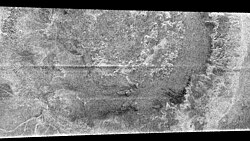
Callisto, or Jupiter IV, is the second-largest moon of Jupiter, after Ganymede. In the Solar System it is the third-largest moon after Ganymede and Saturn's largest moon Titan, and as large as the smallest planet Mercury, though only about a third as massive. Callisto is, with a diameter of 4,821 km, roughly a third larger than Earth's Moon and orbits Jupiter on average at a distance of 1,883,000 km, which is about six times further out than the Moon orbiting Earth. It is the outermost of the four large Galilean moons of Jupiter, which were discovered in 1610 with one of the first telescopes, being visible from Earth with common binoculars.

Titan is the largest moon of Saturn and the second-largest in the Solar System. It is the only moon known to have an atmosphere denser than the Earth's, and is the only known object in space other than Earth on which clear evidence of stable bodies of surface liquid has been found. Titan is one of the seven gravitationally rounded moons of Saturn and the second-most distant among them. Frequently described as a planet-like moon, Titan is 50% larger than Earth's Moon and 80% more massive. It is the second-largest moon in the Solar System after Jupiter's moon Ganymede, and is larger than Mercury, but only 40% as massive due to Mercury being made of mostly dense iron and rock, while a large portion of Titan is made of less-dense ice.

Rhea is the second-largest moon of Saturn and the ninth-largest moon in the Solar System, with a surface area that is comparable to the area of Australia. It is the smallest body in the Solar System for which precise measurements have confirmed a shape consistent with hydrostatic equilibrium. It was discovered in 1672 by Giovanni Domenico Cassini.

Tethys, or Saturn III, is the fifth-largest moon of Saturn, measuring about 1,060 km (660 mi) across. It was discovered by Giovanni Domenico Cassini in 1684, and is named after the titan Tethys of Greek mythology.

Iapetus is the outermost of Saturn's large moons. With an estimated diameter of 1,469 km, it is the third-largest moon of Saturn and the eleventh-largest in the Solar System. Named after the Titan Iapetus, the moon was discovered in 1671 by Giovanni Domenico Cassini.

Enceladus is the sixth-largest moon of Saturn and the 19th-largest in the Solar System. It is about 500 kilometers in diameter, about a tenth of that of Saturn's largest moon, Titan. It is mostly covered by fresh, clean ice, making it one of the most reflective bodies of the Solar System. Consequently, its surface temperature at noon reaches only −198 °C, far colder than a light-absorbing body would be. Despite its small size, Enceladus has a wide variety of surface features, ranging from old, heavily cratered regions to young, tectonically deformed terrain.

The moons of Saturn are numerous and diverse, ranging from tiny moonlets only tens of meters across to the enormous Titan, which is larger than the planet Mercury. There are 146 moons with confirmed orbits, the most of any planet in the solar system. This number does not include the many thousands of moonlets embedded within Saturn's dense rings, nor hundreds of possible kilometer-sized distant moons that were seen through telescopes but not recaptured. Seven Saturnian moons are large enough to have collapsed into a relaxed, ellipsoidal shape, though only one or two of those, Titan and possibly Rhea, are currently in hydrostatic equilibrium. Three moons are particularly notable. Titan is the second-largest moon in the Solar System, with a nitrogen-rich Earth-like atmosphere and a landscape featuring river networks and hydrocarbon lakes. Enceladus emits jets of ice from its south-polar region and is covered in a deep layer of snow. Iapetus has contrasting black and white hemispheres as well as an extensive ridge of equatorial mountains among the tallest in the solar system.

Stickney is the largest crater on Phobos, which is a satellite of Mars. It is 9 km (5.6 mi) in diameter, taking up a substantial proportion of the moon's surface.

Herschel is a 304 kilometer impact crater in the Martian southern hemisphere, at 14.5°S, 130°E, located in the Mare Tyrrhenum region of Mars. The crater is jointly named after the seventeenth/eighteenth century father and son astronomers William Herschel and John Herschel.

Lunar craters are impact craters on Earth's Moon. The Moon's surface has many craters, all of which were formed by impacts. The International Astronomical Union currently recognizes 9,137 craters, of which 1,675 have been dated.

Secondary craters are impact craters formed by the ejecta that was thrown out of a larger crater. They sometimes form radial crater chains. In addition, secondary craters are often seen as clusters or rays surrounding primary craters. The study of secondary craters exploded around the mid-twentieth century when researchers studying surface craters to predict the age of planetary bodies realized that secondary craters contaminated the crater statistics of a body's crater count.
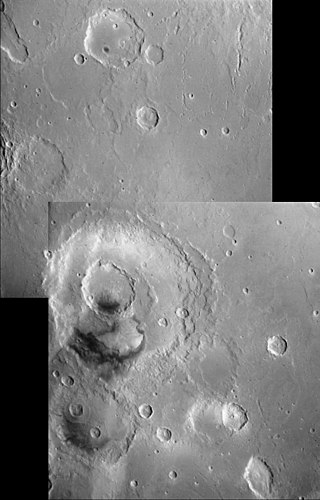
Becquerel is a 167 km-diameter crater at 22.1°N, 352.0°E on Mars, in Arabia Terra in Oxia Palus quadrangle. It is named after Antoine H. Becquerel.
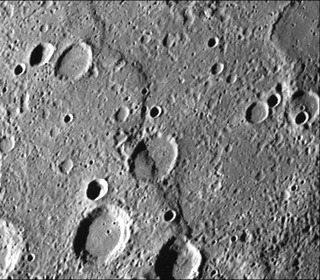
Inter-crater plains on Mercury are a land-form consisting of plains between craters on Mercury.
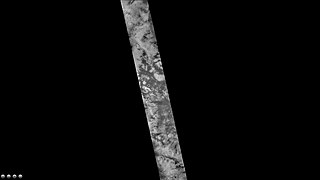
Main is an impact crater on Mars, located in the Mare Australe quadrangle at 76.6°S latitude and 310.9°W longitude. It measures 109.0 kilometers in diameter and was named after Rev. Robert Main. The name was approved in 1973, by the International Astronomical Union (IAU) Working Group for Planetary System Nomenclature (WGPSN). The floor of Main shows dark portions which are caused by pressurized carbon dioxide blowing dust in the atmosphere in the spring when the temperature goes up. Some of the dust is shaped into streaks if there is a wind.
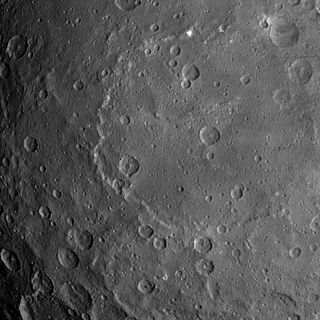
Kerwan is the largest confirmed crater and one of the largest geological features on Ceres. It was discovered on February 19, 2015 from Dawn images as it approached Ceres. The crater is distinctly shallow for its size, and lacks a central peak. A central peak might have been destroyed by a 15-kilometer-wide crater at the center of Kerwan. The crater is likely to be young relative to the rest of Ceres's surface, as Kerwan has largely obliterated the cratering in the southern part of Vendimia Planitia.

A multi-ringed basin is not a simple bowl-shaped crater, or a peak ring crater, but one containing multiple concentric topographic rings; a multi-ringed basin could be described as a massive impact crater, surrounded by circular chains of mountains resembling rings on a bull's-eye. A multi-ringed basin may have an area of many thousands of square kilometres.

Elivagar Flumina is a network of river channels ranging from 23 km to 210 km in length in the region around the Menrva Crater of Titan. The channel system is at least 120 km wide and shows signs of erosion. At its mouth, an alluvial fan is present. The Elivagar Flumina is interpreted as alluvial due to its closeness to fluvial valleys and as understood from the radar backscatter. Geomorphologic mapping of the Menrva region of Titan has yielded evidence for exogenic processes such as hydrocarbon fluid channelization that are thought to have formed the Flumina network.

PateraPAT-ər-ə is an irregular crater, or a complex crater with scalloped edges on a celestial body. Paterae can have any origin, although the majority of them were created by volcanism. The term comes from Latin, where it refers to a shallow bowl used in antique cultures.
